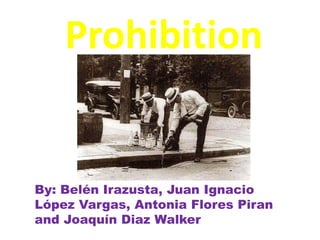
Prohibition in 1920's
- 1. Prohibition By: Belén Irazusta, Juan Ignacio López Vargas, Antonia Flores Piran and Joaquín Diaz Walker
- 2. Why was Prohibition introduced? - Rural areas of the USA there was a big “temperance” movement - They agreed not to drink alcohol and to get others to give up alcohol. - Main movements: Anti-Saloon League and the Women`s Christians Temperance Union.(they persuade the government to prohibit the sale of alcohol) - The campaign gathered pace, they became a national campaign to prohibit alcohol. They became known as “dries” - When USA went to the WW1, drinkers were accused of being unpatriotic cowards - Saloons were seen as dens of vice that destroyed family life - the “Eighteenth Amendment”
- 4. How was prohibition enforced - Prohibition lasted from1920 to 1933 - Levels of alcohol consumption fell by about 3o% in the early 1920s - Prohibition gained widespread approval in rural areas but in urban areas wasn’t popular - Government arrested the offenders - The most famous agents: Isadore Einstein and his deputy Moe Smith(diaz)
- 5. Supply and demand - Work of agents - Biggest drawback - Bootleggers - Al Capone-Speakeasy. Al Capone`s view:”Prohibition is a business. All I do is supply a public demand” - Illegal stills or speakeasy - Izzy Einstein filed a report to his superiors on how easy it was to find alcohol after arriving in a new city Chicago: 21 minutes Atlanta: 17 minutes Pittsburg: 11 minutes New Orleans: 35 seconds - People made their own illegal whisk – moonshine. Alcohol frequently poisonous. - Captain McCoy(Finest Scotch Whisky)
- 7. Corruption - Prohibition led to massive corruption - officers involved with the liquor trade - Breweries were in the Prohibition era - They bribed local government officers, agents and police - When arrests were made, it was difficult to get convictions because more senior officers or even judges were in the pay of the criminals - One of twelve agents were dismissed for corruption.
- 8. Chicago and the gangsters - Gangsters sale illegal alcohol. - The bootlegger George Remus did well from the trade. - Gangsters came from immigrant backgrounds - Dan O`Banion, Pete and Vince Guizenberg and Lucky Luciano were some of the most powerful gangster. - George remus Lucky Luciano
- 9. - The Gangs fought viciously with each other to control the liquor trade and also the prostitution. - They made use of new technology , especially automobiles and the Thompson sub-machine gun. It was very powerful and it could be carried around and hidden under an overcoat. - (in 1926 and 1927 ) A lot of deaths and not one arrest.
- 10. - Gangsters operated all over the USA, but they were most associated with Chicago - Gangster boss Al Capone (Al Capone took his over and proved to be a formidable gangland boss) - Johnny Torio - Al Capone built a huge network of corrupt officials among Chicago`s police, local government, etc - William Hale Thompson - He killed two of his own men whom he suspected - By 1929 Al Capone destroyed the power of the other Chicago gangs, commenting 300 murders in the process. - St Valentine`s Day Massacre.
- 11. Why was prohibition ended - St Valentine`s Day (Gangsters graduated from murder to masacre) - “The noble experiment”(It failed) It had made Usa lawless, Police corrupt, and gangsters powerful and rich -1930 depression -Prohibition repealed Franking D Rosevelt
- 12. HOPE YOU ENJOY IT! By, Antonia Flores Piran Juani Lopez Vargas Belen Irazusta and Joaquin Diaz Walker
